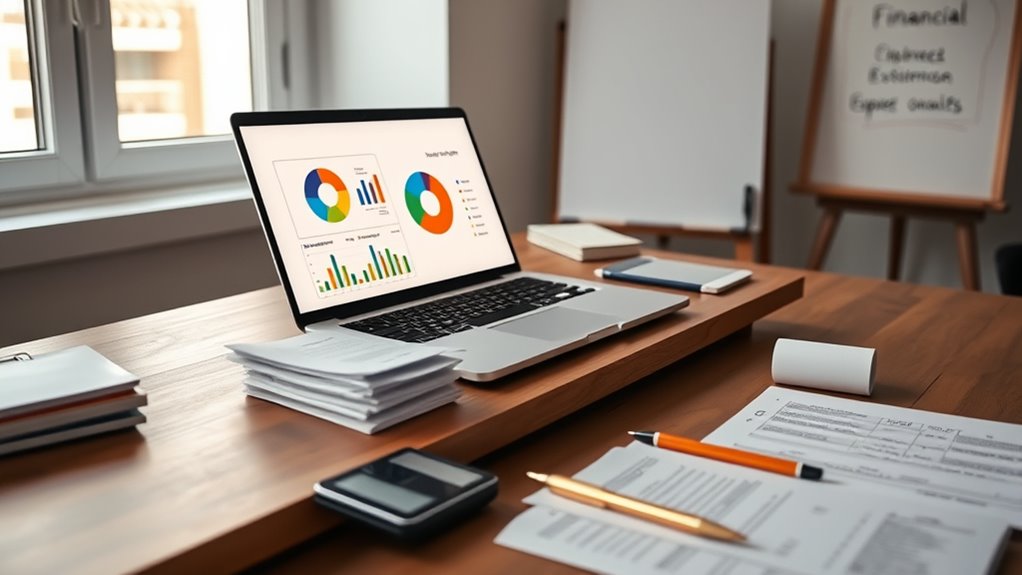To monitor your spending effectively, start by choosing a method that fits your lifestyle, like a budgeting app or a simple spreadsheet. Track every expense regularly, categorizing each to see where your money goes. Set clear financial goals and review your progress periodically. Stay consistent by automating payments and using visual tools to spot patterns. Keep motivated by celebrating small wins. Keep exploring to discover additional tips for mastering your expenses.
Key Takeaways
- Choose a tracking method that suits your lifestyle, such as apps, spreadsheets, or envelopes, to ensure consistency.
- Categorize expenses regularly to identify spending patterns and areas for potential savings.
- Set specific financial goals and review spending habits frequently to stay aligned with your objectives.
- Automate bill payments and use alerts to prevent missed payments and overspending.
- Analyze your expenses over time with visual tools to recognize trends and adjust budgets proactively.
Understanding the Importance of Expense Tracking

Understanding the importance of expense tracking is essential if you want to manage your finances effectively. When you track your expenses, you gain a clear picture of where your money goes each month. This awareness helps you identify unnecessary spending and prioritize your financial goals. Without tracking, it’s easy to overlook small expenses that add up over time, making budgeting difficult. By keeping a detailed record, you can see patterns and adjust your habits accordingly. Expense tracking also provides motivation, as you can measure progress toward saving or debt reduction. It’s a simple yet powerful tool that puts you in control of your financial future. The more consistent you are, the better you’ll understand your spending habits and make informed decisions. Maintaining a record of your expenses can also help ensure transparency about your financial situation, making it easier to stay accountable and make adjustments as needed. Incorporating automated expense tracking tools can further streamline this process and reduce manual effort.
Setting Clear Financial Goals

Once you’ve started tracking your expenses, the next step is to set clear financial goals. Without specific goals, your spending habits may lack direction, making it harder to stay motivated. Decide what you want to achieve—whether it’s saving for a vacation, paying off debt, or building an emergency fund. Make your goals S.M.A.R.T.: Specific, Measurable, Achievable, Relevant, and Time-bound. For example, instead of saying “save money,” aim to save $5,000 in one year. Clear goals give you a target to work toward and help you prioritize your spending. Write them down and review them regularly to stay focused. Having well-defined financial goals keeps you accountable and guides your expense tracking efforts effectively.
Choosing the Right Expense Tracking Method
Choosing the right expense tracking method is essential because it determines how effectively you’ll monitor your spending and stay aligned with your financial goals. Consider your habits, tech comfort level, and preferences. Do you prefer a manual approach or digital tools? Some methods include paper logs, spreadsheets, or mobile apps. Evaluate these options with the table below:
| Method | Best For |
|---|---|
| Paper Ledger | Hands-on, minimal tech |
| Spreadsheets | Customization, detailed tracking |
| Mobile Apps | Convenience, on-the-go updates |
| Envelope System | Cash-based, budget control |
| Budget Journals | Structured, goal-oriented |
Select a method that fits your lifestyle and encourages consistency. The right choice makes tracking less burdensome and more effective. Additionally, understanding the environmental impacts of your choices can motivate more sustainable financial habits. Being aware of how your tracking methods influence both your finances and the environment can lead to more conscientious decisions. Incorporating eco-friendly practices such as reducing paper waste by choosing digital solutions can further support sustainability. Using digital tools can also reduce paper waste, contributing to eco-friendly practices. Incorporating digital solutions can further streamline your process and reduce clutter.
Utilizing Budgeting Apps and Software
Have you considered how budgeting apps and software can simplify your financial management? These tools automate tracking, making it easier to stay on top of your spending. They sync with your bank accounts, providing real-time updates and reducing manual entry. Here are some benefits:
Budgeting apps simplify finances with real-time updates and automated tracking.
- Customizable budgets tailored to your income and expenses
- Alerts for overspending or bill due dates
- Visual reports that help you identify spending patterns
- Goal tracking to stay motivated and focused on savings
- Understanding your financial habits can also support your overall financial health and lead to better money management decisions. Additionally, integrating features like adjustable settings allows for greater control over your financial goals. Recognizing emotional spending patterns can further improve your budgeting strategies and prevent impulsive purchases. Being aware of expenditure habits can help you develop more disciplined spending routines.
Using these apps, you gain better control and insight into your finances with minimal effort. They streamline the process, helping you make informed decisions quickly and confidently. Investing in quality budgeting software can considerably enhance your overall financial discipline.
Categorizing and Analyzing Your Spending

By organizing your expenses into clear categories, you can better see where your money goes each month. Tracking your spending patterns helps you spot trends and areas to cut back. This process makes it easier to find cost-saving opportunities and improve your overall financial health. Paying attention to specific spending categories can also help you understand how different areas of your budget contribute to your financial goals. Incorporating mindful budgeting strategies can further enhance your ability to manage your finances responsibly. Using sustainable packaging for your purchases can also promote eco-friendly habits and reduce waste, aligning your financial discipline with environmental consciousness.
Organize Expense Categories
How can you make sense of your spending habits? Organizing expense categories helps clarify where your money goes. First, group similar expenses, like groceries, entertainment, and utilities, to identify patterns. Second, set clear labels for each category to guarantee consistent tracking. Third, prioritize categories based on your financial goals, such as saving or debt repayment. Fourth, review these groups regularly to spot trends and adjust your budget accordingly. Proper categorization provides insight into your financial behavior, making it easier to control spending and allocate funds wisely. Additionally, understanding offensive security measures can help you better grasp how to protect your finances from potential threats. Incorporating techniques like data encryption can further safeguard your financial information from digital vulnerabilities. Being aware of financial security best practices can also help prevent fraud or unauthorized access to your accounts, especially when combined with knowledge about website privacy policies and how they safeguard user data. Staying informed about cybersecurity techniques can enhance your overall financial safety and reduce risks associated with online transactions.
Track Spending Patterns
Tracking your spending patterns involves actively categorizing each expense and analyzing how your money flows across different areas. By reviewing your transactions regularly, you can see which categories consume most of your budget. Break down your expenses into groups like groceries, entertainment, transportation, and bills. This helps you identify trends and habits, such as frequent dining out or impulse buys. Analyzing your spending data reveals where your money goes and highlights areas that may need adjustment. Use charts or spreadsheets to visualize your patterns, making it easier to spot inconsistencies or spikes. Consistent tracking empowers you to understand your financial behavior better, giving you the knowledge needed to make informed decisions and maintain control over your finances. Incorporating budgeting techniques can further refine your expense management efforts.
Identify Cost-saving Opportunities
Reviewing your spending patterns reveals opportunities to cut costs and save more money. Once you understand where your money goes, you can identify areas to optimize. Consider these key strategies:
- Categorize expenses to see which categories dominate your spending, such as dining out or subscriptions. Proper categorization can help you target specific areas for savings and better understand your habits. Incorporating expense categorization can further clarify your financial picture. Additionally, leveraging powerful persuasive words in your financial decisions can motivate better saving habits. To enhance your analysis, consider tracking your expenses with mobile apps for real-time insights.
- Compare costs for recurring bills to find cheaper alternatives or negotiate better rates. Looking into cost-saving techniques can further enhance your efforts.
- Spot impulse purchases that don’t add value and can be cut back.
- Analyze spending trends over time to identify seasonality or habits that inflate expenses. Recognizing these patterns allows for more mindful budgeting.
- Incorporating industry trends into your analysis can help you stay informed about new ways to reduce costs and maximize savings.
Monitoring and Adjusting Your Budget Regularly

To keep your budget on track, it’s important to review it regularly. Scheduling consistent budget checks helps you spot spending patterns and make adjustments early. By staying proactive, you guarantee your finances stay aligned with your goals.
Schedule Budget Reviews
How often should you check in on your budget to stay on track? Regular reviews guarantee you’re aligned with your financial goals. Ideally, you should schedule reviews:
- Weekly, to catch small overspending early
- Monthly, for an extensive overview of expenses and income
- Quarterly, to assess progress toward larger financial targets
- Annually, to evaluate overall financial health and plan adjustments
Identify Spending Patterns
Have you noticed certain expenses recurring each month or surprising spikes in your spending? Identifying these patterns helps you understand where your money goes and highlights areas for improvement. Review your transaction history regularly to spot trends, such as frequent dining out or impulse purchases. Notice if specific categories, like entertainment or groceries, consistently take up a large portion of your budget. Recognizing these patterns allows you to set realistic limits and adjust your habits accordingly. For example, if dining out is a recurring expense, consider cooking at home more often. Tracking these patterns also reveals seasonal or one-time costs that might skew your overall spending. Understanding your habits empowers you to make informed decisions and maintain better control over your finances.
Tips for Staying Consistent and Motivated
Staying consistent with expense tracking can be challenging, especially when motivation wanes over time. To keep yourself on track, try these strategies:
- Set small, achievable goals to build confidence and momentum.
- Schedule regular check-ins, like weekly reviews, to reinforce habits.
- Use visual tools, such as charts or graphs, to see your progress clearly.
- Reward yourself for milestones to maintain motivation.
Overcoming Common Challenges in Expense Management

Managing expenses often presents unexpected hurdles, from impulsive spending to inconsistent record-keeping. To overcome these challenges, set clear budgets and stick to them. Use tools like apps or spreadsheets to track every expense accurately, making it easier to identify spending patterns. When you feel tempted to splurge, pause and ask yourself if it’s a necessary purchase. Automate payments and alerts to stay on top of bills, reducing the risk of missed deadlines. If you slip up, don’t get discouraged—review what caused the mistake and adjust your strategies. Building habits takes time, so stay committed and patient. By actively addressing these common issues, you’ll find expense management becomes more manageable and less stressful, helping you stay financially on track.
Frequently Asked Questions
How Often Should I Review My Expense Tracking Data?
You should review your expense tracking data regularly to stay on top of your finances. Weekly reviews help you catch overspending early and adjust your budget if needed. If your finances are more complex, consider checking your expenses bi-weekly or monthly. Consistency is key, so choose a schedule that fits your lifestyle and stick to it. This way, you’ll maintain better control and make smarter financial decisions.
What Are Signs I’M Overspending Despite Tracking Expenses?
You might notice your spending creeping into unfamiliar territory, even with a good tracking system. Signs include consistently going over your budget, feeling stressed about money, or realizing your savings are shrinking faster than planned. If you’re making frequent unplanned purchases or ignoring your financial goals, it’s a clear sign you’re overspending. Stay mindful, adjust your habits, and revisit your budget to keep your finances healthy and balanced.
Can Expense Tracking Improve My Long-Term Financial Health?
Tracking your expenses can substantially improve your long-term financial health. When you monitor your spending, you identify patterns, eliminate unnecessary costs, and make informed decisions. This awareness helps you set realistic goals, build savings, and avoid debt. By consistently reviewing your expenses, you stay accountable and adapt your habits as needed. Over time, this proactive approach leads to better financial stability and more control over your future.
How Do I Handle Forgotten or Unrecorded Expenses?
When you forget or don’t record expenses, don’t panic. Review your bank and credit card statements regularly to identify any missed transactions. Add these expenses to your tracking system, adjusting your budget if needed. Going forward, set aside time daily or weekly to log expenses immediately. This habit helps you stay accurate, prevents future forgetfulness, and keeps your financial picture clear, making it easier to manage your money.
What Are Common Mistakes to Avoid When Monitoring Spending?
When monitoring your spending, avoid common mistakes like neglecting to record every expense, which skews your budget. Don’t rely solely on memory; always log expenses immediately. Overlooking small purchases can add up over time, so track them too. Also, resist the temptation to adjust your budget impulsively without reviewing your actual spending. Staying disciplined and consistent helps you gain a clear picture of your financial habits.
Conclusion
By tracking your expenses consistently, you take control of your finances and pave the way for financial stability. Did you know that people who monitor their spending are 30% more likely to meet their financial goals? Stay committed, review your progress regularly, and adjust as needed. With persistence and the right tools, you’ll build healthier habits and achieve your financial dreams faster than you might expect.










